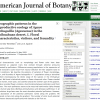
Autores:
Silva-Montellano, A.
L. E. Eguiarte
Revista y/o libro:
American Journal of Botany
Volumen:
90(3), 377- 388
Año:
2003
Sinopsis:
Floral characteristics such as morphology and flower color have been interpreted as adaptive traits that evolved through selective pressures generated by pollinators. Differences among populations in the expression of floral characters could result from natural selection for their adaptive value to local conditions. We describe the patterns of variation of flower morphology, color, and fecundity of Agave lechuguilla in 11 populations along a latitudinal gradient encompassing the whole range of the species in the Chihuahuan desert. We found a latitudinal pattern in flower shape and color. Flowers tended to be shorter, more open, and colorful toward the northern part of the gradient. We also recorded flower visitation, discriminating between pollinators and floral robbers. The main pollinators seems to be nocturnal hawk moths (Hyles lineata) and diurnal large bees (Bombus pennsylvanicus and Xylocopa californica). In all populations large bees were the most abundant potential pollinators. However, the abundance of the potential pollinators varied along the gradient. We observed no bat visits along the gradient. The number of visits by all potential pollinators decreased significantly with latitude as did fruit set.